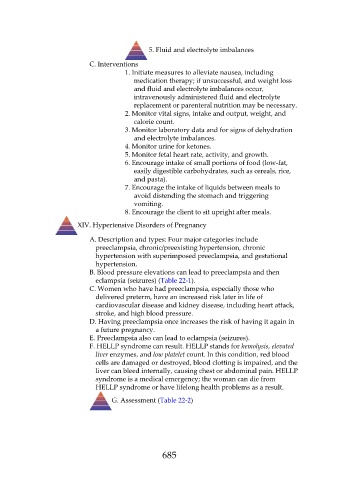Page 685 - Saunders Comprehensive Review For NCLEX-RN
P. 685
5. Fluid and electrolyte imbalances
C. Interventions
1. Initiate measures to alleviate nausea, including
medication therapy; if unsuccessful, and weight loss
and fluid and electrolyte imbalances occur,
intravenously administered fluid and electrolyte
replacement or parenteral nutrition may be necessary.
2. Monitor vital signs, intake and output, weight, and
calorie count.
3. Monitor laboratory data and for signs of dehydration
and electrolyte imbalances.
4. Monitor urine for ketones.
5. Monitor fetal heart rate, activity, and growth.
6. Encourage intake of small portions of food (low-fat,
easily digestible carbohydrates, such as cereals, rice,
and pasta).
7. Encourage the intake of liquids between meals to
avoid distending the stomach and triggering
vomiting.
8. Encourage the client to sit upright after meals.
XIV. Hypertensive Disorders of Pregnancy
A. Description and types: Four major categories include
preeclampsia, chronic/preexisting hypertension, chronic
hypertension with superimposed preeclampsia, and gestational
hypertension.
B. Blood pressure elevations can lead to preeclampsia and then
eclampsia (seizures) (Table 22-1).
C. Women who have had preeclampsia, especially those who
delivered preterm, have an increased risk later in life of
cardiovascular disease and kidney disease, including heart attack,
stroke, and high blood pressure.
D. Having preeclampsia once increases the risk of having it again in
a future pregnancy.
E. Preeclampsia also can lead to eclampsia (seizures).
F. HELLP syndrome can result. HELLP stands for hemolysis, elevated
liver enzymes, and low platelet count. In this condition, red blood
cells are damaged or destroyed, blood clotting is impaired, and the
liver can bleed internally, causing chest or abdominal pain. HELLP
syndrome is a medical emergency; the woman can die from
HELLP syndrome or have lifelong health problems as a result.
G. Assessment (Table 22-2)
685

